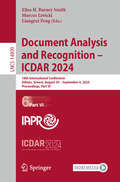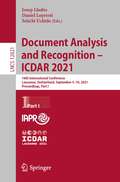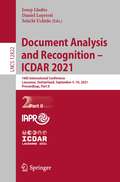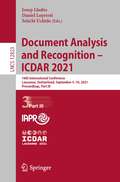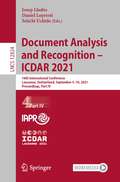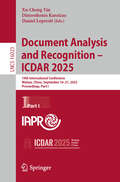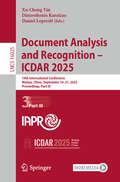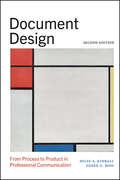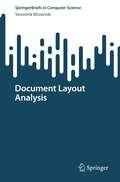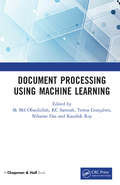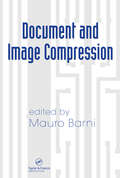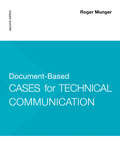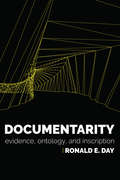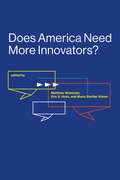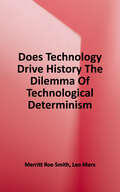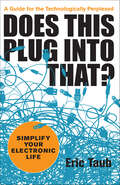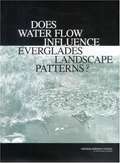- Table View
- List View
Document Analysis and Recognition - ICDAR 2024: 18th International Conference, Athens, Greece, August 30–September 4, 2024, Proceedings, Part VI (Lecture Notes in Computer Science #14809)
by Elisa H. Barney Smith Marcus Liwicki Liangrui PengThis six-volume set LNCS 14804-14809 constitutes the proceedings of the 18th International Conference on Document Analysis and Recognition, ICDAR 2024, held in Athens, Greece, during August 30–September 4, 2024. The total of 144 full papers presented in these proceedings were carefully selected from 263 submissions. The papers reflect topics such as: document image processing; physical and logical layout analysis; text and symbol recognition; handwriting recognition; document analysis systems; document classification; indexing and retrieval of documents; document synthesis; extracting document semantics; NLP for document understanding; office automation; graphics recognition; human document interaction; document representation modeling and much more.
Document Analysis and Recognition – ICDAR 2021 Workshops: Lausanne, Switzerland, September 5–10, 2021, Proceedings, Part II (Lecture Notes in Computer Science #12917)
by Elisa H. Barney Smith Umapada PalThis book constitutes the proceedings of the international workshops co-located with the 16th International Conference on Document Analysis and Recognition, ICDAR 2021, held in Lausanne, Switzerland, in September 2021.The total of 59 full and 12 short papers presented in this book were carefully selected from 96 submissions and divided into two volumes. Part II contains 30 full and 8 short papers that stem from the following meetings: Workshop on Machine Learning (WML); Workshop on Open Services and Tools for Document Analysis (OST); Workshop on Industrial Applications of Document Analysis and Recognition (WIADAR); Workshop on Computational Paleography (IWCP); Workshop on Document Images and Language (DIL); Workshop on Graph Representation Learning for Scanned Document Analysis (GLESDO).
Document Analysis and Recognition – ICDAR 2021: 16th International Conference, Lausanne, Switzerland, September 5–10, 2021, Proceedings, Part I (Lecture Notes in Computer Science #12821)
by Daniel Lopresti Josep Lladós Seiichi UchidaThis four-volume set of LNCS 12821, LNCS 12822, LNCS 12823 and LNCS 12824, constitutes the refereed proceedings of the 16th International Conference on Document Analysis and Recognition, ICDAR 2021, held in Lausanne, Switzerland in September 2021. The 182 full papers were carefully reviewed and selected from 340 submissions, and are presented with 13 competition reports.The papers are organized into the following topical sections: historical document analysis, document analysis systems, handwriting recognition, scene text detection and recognition, document image processing, natural language processing (NLP) for document understanding, and graphics, diagram and math recognition.
Document Analysis and Recognition – ICDAR 2021: 16th International Conference, Lausanne, Switzerland, September 5–10, 2021, Proceedings, Part II (Lecture Notes in Computer Science #12822)
by Daniel Lopresti Josep Lladós Seiichi UchidaThis four-volume set of LNCS 12821, LNCS 12822, LNCS 12823 and LNCS 12824, constitutes the refereed proceedings of the 16th International Conference on Document Analysis and Recognition, ICDAR 2021, held in Lausanne, Switzerland in September 2021. The 182 full papers were carefully reviewed and selected from 340 submissions, and are presented with 13 competition reports.The papers are organized into the following topical sections: document analysis for literature search, document summarization and translation, multimedia document analysis, mobile text recognition, document analysis for social good, indexing and retrieval of documents, physical and logical layout analysis, recognition of tables and formulas, and natural language processing (NLP) for document understanding.
Document Analysis and Recognition – ICDAR 2021: 16th International Conference, Lausanne, Switzerland, September 5–10, 2021, Proceedings, Part III (Lecture Notes in Computer Science #12823)
by Daniel Lopresti Josep Lladós Seiichi UchidaThis four-volume set of LNCS 12821, LNCS 12822, LNCS 12823 and LNCS 12824, constitutes the refereed proceedings of the 16th International Conference on Document Analysis and Recognition, ICDAR 2021, held in Lausanne, Switzerland in September 2021. The 182 full papers were carefully reviewed and selected from 340 submissions, and are presented with 13 competition reports.The papers are organized into the following topical sections: extracting document semantics, text and symbol recognition, document analysis systems, office automation, signature verification, document forensics and provenance analysis, pen-based document analysis, human document interaction, document synthesis, and graphs recognition.
Document Analysis and Recognition – ICDAR 2021: 16th International Conference, Lausanne, Switzerland, September 5–10, 2021, Proceedings, Part IV (Lecture Notes in Computer Science #12824)
by Daniel Lopresti Josep Lladós Seiichi UchidaThis four-volume set of LNCS 12821, LNCS 12822, LNCS 12823 and LNCS 12824, constitutes the refereed proceedings of the 16th International Conference on Document Analysis and Recognition, ICDAR 2021, held in Lausanne, Switzerland in September 2021. The 182 full papers were carefully reviewed and selected from 340 submissions, and are presented with 13 competition reports.The papers are organized into the following topical sections: scene text detection and recognition, document classification, gold-standard benchmarks and data sets, historical document analysis, and handwriting recognition. In addition, the volume contains results of 13 scientific competitions held during ICDAR 2021.
Document Analysis and Recognition – ICDAR 2025: 19th International Conference, Wuhan, China, September 16–21, 2025, Proceedings, Part I (Lecture Notes in Computer Science #16023)
by Daniel Lopresti Dimosthenis Karatzas Xu-Cheng YinThe 5-volume set LNCS 16023 - 16027 constitutes the proceedings of the 19th International Conference on Document Analysis and Recognition, ICDAR 2025, which took place in Wuhan, China, during September 2025. The total of 142 full papers included in the proceedings was carefully reviewed and selected from 314 submissions. They were organized in topical sections as follows: Part I: Document Analysis; Handwriting Recognition; Document Synthesis, Multimodal Models for Document Understanding; NLP for Document Understanding; Part II: Historical Document Analysis; Trustworthy Document Analysis Methods and Documentation; Handwriting Recognition; Camera Based Methods and Font Analysis; Part III: Poster Papers; Part IV: Poster Papers; Part V: Poster Papers; Competitions.
Document Analysis and Recognition – ICDAR 2025: 19th International Conference, Wuhan, China, September 16–21, 2025, Proceedings, Part III (Lecture Notes in Computer Science #16025)
by Daniel Lopresti Dimosthenis Karatzas Xu-Cheng YinThe 5-volume set LNCS 16023 - 16027 constitutes the proceedings of the 19th International Conference on Document Analysis and Recognition, ICDAR 2025, which took place in Wuhan, China, during September 2025. The total of 142 full papers included in the proceedings was carefully reviewed and selected from 314 submissions. They were organized in topical sections as follows: Part I: Document Analysis; Handwriting Recognition; Document Synthesis, Multimodal Models for Document Understanding; NLP for Document Understanding; Part II: Historical Document Analysis; Trustworthy Document Analysis Methods and Documentation; Handwriting Recognition; Camera Based Methods and Font Analysis; Part III: Poster Papers; Part IV: Poster Papers; Part V: Poster Papers; Competitions.
Document Design: From Process to Product in Professional Communication (SUNY series, Studies in Technical Communication)
by Miles A. Kimball Derek G. RossIntroduces students to the basic principles and theories of design, combining practical advice about the design process with a foundation in visual rhetoric and usability.Document Design introduces students to the basic principles and theories of design, combining practical advice about the design process with a foundation in visual rhetoric and usability. Most books on document design lean toward either theory or practice. This book offers a balanced approach-theoretically informed practice-that introduces a working vocabulary to help students become reflective practitioners, able not only to create effective designs but also to explain why and how they made their design choices. Derek G. Ross and Miles A. Kimball hope to give students the foundation they need to make design decisions in any rhetorical situation. Students will learn to negotiate between the needs of both users and clients to consider the nuances of audience, purpose, and context.
Document Layout Analysis (SpringerBriefs in Computer Science)
by Showmik BhowmikDocument layout analysis (DLA) is a crucial step towards the development of an effective document image processing system. In the early days of document image processing, DLA was not considered as a complete and complex research problem, rather just a pre-processing step having some minor challenges. The main reason for that is the type of layout being considered for processing was simple. Researchers started paying attention to this complex problem as they come across a large variety of documents. This book presents a clear view of the past, present, and future of DLA, and it also discusses two recent methods developed to address the said problem.
Document Processing Using Machine Learning
by Kaushik Roy Teresa Gonçalves K. C. Santosh Sk Md Obaidullah Nibaran DasDocument Processing Using Machine Learning aims at presenting a handful of resources for students and researchers working in the document image analysis (DIA) domain using machine learning since it covers multiple document processing problems. Starting with an explanation of how Artificial Intelligence (AI) plays an important role in this domain, the book further discusses how different machine learning algorithms can be applied for classification/recognition and clustering problems regardless the type of input data: images or text. In brief, the book offers comprehensive coverage of the most essential topics, including: · The role of AI for document image analysis · Optical character recognition · Machine learning algorithms for document analysis · Extreme learning machines and their applications · Mathematical foundation for Web text document analysis · Social media data analysis · Modalities for document dataset generation This book serves both undergraduate and graduate scholars in Computer Science/Information Technology/Electrical and Computer Engineering. Further, it is a great fit for early career research scientists and industrialists in the domain.
Document and Image Compression (Signal Processing and Communications)
by Mauro BarniAlthough it's true that image compression research is a mature field, continued improvements in computing power and image representation tools keep the field spry. Faster processors enable previously intractable compression algorithms and schemes, and certainly the demand for highly portable high-quality images will not abate. Document and Image Compression highlights the current state of the field along with the most probable and promising future research directions for image coding.Organized into three broad sections, the book examines the currently available techniques, future directions, and techniques for specific classes of images. It begins with an introduction to multiresolution image representation, advanced coding and modeling techniques, and the basics of perceptual image coding. This leads to discussions of the JPEG 2000 and JPEG-LS standards, lossless coding, and fractal image compression. New directions are highlighted that involve image coding and representation paradigms beyond the wavelet-based framework, the use of redundant dictionaries, the distributed source coding paradigm, and novel data-hiding techniques. The book concludes with techniques developed for classes of images where the general-purpose algorithms fail, such as for binary images and shapes, compound documents, remote sensing images, medical images, and VLSI layout image data. Contributed by international experts, Document and Image Compression gathers the latest and most important developments in image coding into a single, convenient, and authoritative source.
Document-Based Cases for Technical Communication
by Roger MungerWith seven context-rich scenarios and more than 50 sample documents to analyze, revise, and design, this booklet offers students realistic opportunities to practice writing in the workplace. The new edition features a fresh new design and new cases and writing tasks that incorporate online genres and social media tools. A companion Web site provides digital versions of all the documents in the book for students to download and work with as well as new scoring guides for instructors.
Documentarity: Evidence, Ontology, and Inscription (History and Foundations of Information Science)
by Ronald E. DayA historical-conceptual account of the different genres, technologies, modes of inscription, and innate powers of expression by which something becomes evident.In this book, Ronald Day offers a historical-conceptual account of how something becomes evident. Crossing philosophical ontology with documentary ontology, Day investigates the different genres, technologies, modes of inscription, and innate powers of expression by which something comes into presence and makes itself evident. He calls this philosophy of evidence documentarity, and it is through this theoretical lens that he examines documentary evidence (and documentation) within the tradition of Western philosophy, largely understood as representational in its epistemology, ontology, aesthetics, and politics.Day discusses the expression of beings or entities as evidence of what exists through a range of categories and modes, from Plato's notion that ideas are universal types expressed in evidential particulars to the representation of powerful particulars in social media and machine learning algorithms. He considers, among other topics, the contrast between positivist and anthropological documentation traditions; the ontological and epistemological importance of the documentary index; the nineteenth-century French novel's documentary realism and the avant-garde's critique of representation; performative literary genres; expression as a form of self evidence; and the “post-documentation” technologies of social media and machine learning, described as a posteriori, real-time technologies of documentation. Ultimately, the representational means are not only information and knowledge technologies but technologies of judgment, judging entities both descriptively and prescriptively.
Documentary: A History Of The Non-Fiction Film
by Erik BarnouwNow brought completely up to date, the new edition of this classic work on documentary films and filmmaking surveys the history of the genre from 1895 to the present day. With the myriad social upheavals over the past decade, documentaries have enjoyed an international renaissance; here Barnouw considers the medium in the light of an entirely new political and social climate. He examines as well the latest filmmaking technology, and the effects that video cassettes and cable television are having on the production of documentaries. And like the previous editions, Documentary is filled with photographs, many of them rare, collected during the author's travels around the world. Covering the full course of the documentary from Louis Lumiere's first effort to recent landmark productions such as Shoah, this book makes the growing importance of a unique blend of art and reality accessible and understandable to all film lovers.
Documenting Aftermath: Information Infrastructures in the Wake of Disasters (Infrastructures)
by Megan FinnAn examination of how changing public information infrastructures shaped people's experience of earthquakes in Northern California in 1868, 1906, and 1989. When an earthquake happens in California today, residents may look to the United States Geological Survey for online maps that show the quake's epicenter, turn to Twitter for government bulletins and the latest news, check Facebook for updates from friends and family, and count on help from the Federal Emergency Management Agency (FEMA). One hundred and fifty years ago, however, FEMA and other government agencies did not exist, and information came by telegraph and newspaper. In Documenting Aftermath, Megan Finn explores changing public information infrastructures and how they shaped people's experience of disaster, examining postearthquake information and communication practices in three Northern California earthquakes: the 1868 Hayward Fault earthquake, the 1906 San Francisco earthquake and fire, and the 1989 Loma Prieta earthquake. She then analyzes the institutions, policies, and technologies that shape today's postdisaster information landscape.Finn argues that information orders—complex constellations of institutions, technologies, and practices—influence how we act in, experience, and document events. What Finn terms event epistemologies, constituted both by historical documents and by researchers who study them, explain how information orders facilitate particular possibilities for knowledge. After the 1868 earthquake, the Chamber of Commerce telegraphed reassurances to out-of-state investors while local newspapers ran sensational earthquake narratives; in 1906, families and institutions used innovative techniques for locating people; and in 1989, government institutions and the media developed a symbiotic relationship in information dissemination. Today, government disaster response plans and new media platforms imagine different sources of informational authority yet work together shaping disaster narratives.
Documenting the World: Film, Photography, and the Scientific Record
by Gregg Mitman Kelley WilderImagine the twentieth century without photography and film. Its history would be absent of images that define historical moments and generations: the death camps of Auschwitz, the assassination of John F. Kennedy, the Apollo lunar landing. It would be a history, in other words, of just artists' renderings and the spoken and written word. To inhabitants of the twenty-first century, deeply immersed in visual culture, such a history seems insubstantial, imprecise, and even, perhaps, unscientific. Documenting the World is about the material and social life of photographs and film made in the scientific quest to document the world. Drawing on scholars from the fields of art history, visual anthropology, and science and technology studies, the chapters in this book explore how this documentation--from the initial recording of images, to their acquisition and storage, to their circulation--has altered our lives, our ways of knowing, our social and economic relationships, and even our surroundings. Far beyond mere illustration, photography and film have become an integral, transformative part of the world they seek to show us.
Does America Need More Innovators? (Lemelson Center Studies in Invention and Innovation series)
by Matthew Wisnioski Eric S. Hintz Marie Stettler KleineA critical exploration of today's global imperative to innovate, by champions, critics, and reformers of innovation.Corporate executives, politicians, and school board leaders agree—Americans must innovate. Innovation experts fuel this demand with books and services that instruct aspiring innovators in best practices, personal habits, and workplace cultures for fostering innovation. But critics have begun to question the unceasing promotion of innovation, pointing out its gadget-centric shallowness, the lack of diversity among innovators, and the unequal distribution of innovation's burdens and rewards. Meanwhile, reformers work to make the training of innovators more inclusive and the outcomes of innovation more responsible. This book offers an overdue critical exploration of today's global imperative to innovate by bringing together innovation's champions, critics, and reformers in conversation. The book presents an overview of innovator training, exploring the history, motivations, and philosophies of programs in private industry, universities, and government; offers a primer on critical innovation studies, with essays that historicize, contextualize, and problematize the drive to create innovators; and considers initiatives that seek to reform and reshape what it means to be an innovator.ContributorsErrol Arkilic, Catherine Ashcraft, Leticia Britos Cavagnaro, W. Bernard Carlson, Lisa D. Cook, Humera Fasihuddin, Maryann Feldman, Erik Fisher, Benoît Godin, Jenn Gustetic, David Guston, Eric S. Hintz, Marie Stettler Kleine, Dutch MacDonald, Mickey McManus, Sebastian Pfotenhauer, Natalie Rusk, Andrew L. Russell, Lucinda M. Sanders, Brenda Trinidad, Lee Vinsel, Matthew Wisnioski
Does It Fart?: A Kid's Guide to the Gas Animals Pass
by Nick Caruso Dani Rabaiotti Alex G. GriffithsA hilariously informative book of facts, farts, and fun!Dogs fart. Cats fart. Horses fart (a lot). But what about snakes? Spiders? Octopuses? What about chimpanzees? Cheetahs? Or dinosaurs?In this gaseous guide to kids' favorite animals (and some they've probably never heard of), young readers will discover not only which animals pass gas, but also which have the stinkiest farts, which fart the most, and where all this smelly stuff comes from. They'll even learn which species has its own secret fart code! Perfect for reluctant readers, and with full-color illustrations throughout, Does It Fart? is the funniest book you never knew you needed.Based on the New York Times bestseller Does It Fart?: The Definitive Field Guide to Animal Flatulence.
Does Technology Drive History?: The Dilemma of Technological Determinism
by Merritt Roe Smith Leo MarxThese thirteen essays explore a crucial historical question that has been notoriously hard to pin down: To what extent, and by what means, does a society's technology determine its political, social, economic, and cultural forms? <p><p>Karl Marx launched the modern debate on determinism with his provocative remark that "the hand-mill gives you society with the feudal lord; the steam-mill, society with the industrial capitalist," and a classic article by Robert Heilbroner (reprinted here) renewed the debate within the context of the history of technology. This book clarifies the debate and carries it forward. <p><p>Marx's position has become embedded in our culture, in the form of constant reminders as to how our fast-changing technologies will alter our lives. Yet historians who have looked closely at where technologies really come from generally support the proposition that technologies are not autonomous but are social products, susceptible to democratic controls. The issue is crucial for democratic theory. These essays tackle it head-on, offering a deep look at all the shadings of determinism and assessing determinist models in a wide variety of historical contexts. Contributors Bruce Bimber, Richard W. Bulliet, Robert L. Heilbroner, Thomas P. Hughes, Leo Marx, Thomas J. Misa, Peter C. Perdue, Philip Scranton, Merritt Roe Smith, Michael L. Smith, John M. Staudenmaier, Rosalind Williams
Does This Plug into That?: Simplify Your Electronic Life
by Eric TaubSmartphone, router, Blu-ray, LED - America's use of electronics has grown increasingly more challenging since the invention of the light bulb. If you don't know how many pixels your HDTV should contain for maximum viewing pleasure or if you're ready to throw your hands up when you hear that you have to configure your Internet router using the WPA-PSK (TKIP) or WPA-PSK (TKIP) + WPA2-PSK (AES) security protocols, then you need Eric Taub’s Does This Plug Into That?.Taub ignores the jargon and demystifies the technology that can make our lives easier, but usually leaves us bewildered, flummoxed, and defeated - especially after consulting the manufacturer’s installation and usage instructions. Does This Plug into That? cracks the geek code and offers practical advice and directions for everything from purchasing a new TV and setting up a Web connection, to installing a home network and more. Does This Plug Into That? is the all-inclusive resource that will make you smarter than your smartphone while enhancing your gadgetry and electronic prowess.Does This Plug into That? is every consumer's Rosetta Stone, distilling down all the extraneous technical information into simple actions without the gobbledygook. Now you can join the technophile generation without panicking in the process.
Does Water Flow Influence Everglades Landscape Patterns?
by Committee on Restoration of the Greater Everglades EcosystemThe report evaluates a White Paper written by restoration planners in South Florida on the role of water flow in restoration plans. The report concludes that there is strong evidence that the velocity, rate, and spatial distribution of water flow play important roles in maintaining the tree islands and other ecologically important landscape features of the Everglades.
Dog Days, Raven Nights
by John M. Marzluff Colleen MarzluffTwenty years ago, fresh out of graduate school and recently married, John and Colleen Marzluff left Arizona for a small cabin in the mountains of western Maine. Their mission: to conduct the first-ever extensive study of the winter ecology of the Common Raven under the tutelage of biologist Bernd Heinrich. Drawing on field notes and personal diaries, they vividly and eloquently chronicle their three-year endeavor to research a mysterious and often misunderstood bird--assembling a gigantic aviary, climbing sentry trees, building bird blinds in the forest, capturing and sustaining 300 ravens as study subjects, and enduring harsh Maine winters in pursuit of their goal. They also shared the unique challenges and joys of raising, training, and racing the sled dogs that assisted them in their work. Accompanied by Evon Zerbetz's lovely linocut illustrations, Dog Days, Raven Nightsis a fascinating, behind-the-scenes look at the adventures of field science and an insightful exploration of the nature of relationships, both animal and human.
Dog Days: Dispatches from Bedlam Farm
by Jon KatzIn Dog Days, Jon Katz, the squire of Bedlam Farm, allows us to live our dreams of leaving the city for the country, and shares the unpredictable adventure of farm life.
Dog Heroes: Saving Lives and Protecting America
by Jenni BidnerAptly named "man's best friend," dogs often perform extremely heroic and dangerous roles in their jobs. Dog Heroes is the first book to celebrate these brave dogs and their handlers. In addition to high-profile "disaster dogs," the U.S. has a wealth of search dogs performing numerous critical jobs, including seeking out bombs, drugs, land mines, criminals, and abducted children. Author Jen Bidner is a volunteer K9 handler with Illinois- Wisconsin Search & Rescue Dogs (ILL-WIS), a not-for-profit canine unit that helps law enforcement agencies and fire departments in the Midwest find lost and missing people.
